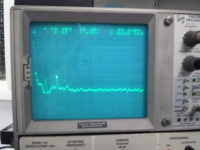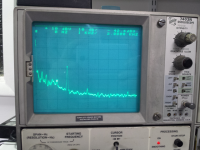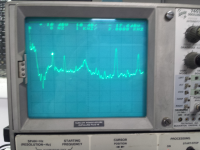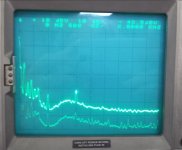Hi Demian,
This is a very good question. Directly related to this question is whether measurements down to -120dB (or whatever) can be done with sound-card-based PC analysis, given the limited sample rate of sound cards and the matter of capturing all significant harmonics (e.g., at minimum, up to the 5th harmonic, or 100kHz).
Cheers,
Bob
They cannot do it. Using two "standards" to compare --- ShibaSoku 725D and AP 2722.... the sound card approach does not accurately measure the individual harmonics below about -100dbv. A notch filter add-on can help these.
I used a variable passive notch filter from B&K (later mod'ed with opamp for sharper notch).
Oh yes, they will show data below -100db.... but it might as well be a random number generator --- no relationship to the Standards measured data. But one day they might do a little better. I like the ease of use with the QA400, for example, and maybe their new upgraded model is better at $450 USD. You can always add a notch filter, too.
And then there is David's modification/upgrades to the 725D.OMG !
THx-RNMarsh
Last edited:
They cannot do it. Using two "standards" to compare --- ShibaSoku 725D and AP 2722.... the sound card approach does not accurately measure the individual harmonics below about -100dbv. A notch filter add-on can help these.
I used a variable passive notch filter from B&K (later mod'ed with opamp for sharper notch).
Oh yes, they will show data below -100db.... but it might as well be a random number generator --- no relationship to the Standards measured data. But one day they might do a little better. I like the ease of use with the QA400, for example, and maybe their new upgraded model is better at $450 USD. You can always add a notch filter, too.
And then there is David's modification/upgrades to the 725D.OMG !
THx-RNMarsh
And repairs.
In this ultra low distortion realm the addition/cancellation of harmonics is a real confounder. Figuring out the real residuals is hard.
I do get some good correlation between the 725 and the AK5394A but thats not real helpful. The AK5394A is only used in a few soundcards that I know of- The Lynx L22, The EMU 1212M and 1616M and the Protools. Its also the the APx 555. I don't have a Lynx but I do have the Emu 1212M and 1616M. The opamps are a limitation in those cards and an upgrade does improve the performance. However the software also drive me nuts with inconsistant results that i have not pinned down. The most reliable and stable results are from Praxis in XP.
I do get some good correlation between the 725 and the AK5394A but thats not real helpful. The AK5394A is only used in a few soundcards that I know of- The Lynx L22, The EMU 1212M and 1616M and the Protools. Its also the the APx 555. I don't have a Lynx but I do have the Emu 1212M and 1616M. The opamps are a limitation in those cards and an upgrade does improve the performance. However the software also drive me nuts with inconsistant results that i have not pinned down. The most reliable and stable results are from Praxis in XP.
They cannot do it. Using two "standards" to compare --- ShibaSoku 725D and AP 2722.... the sound card approach does not accurately measure the individual harmonics below about -100dbv. A notch filter add-on can help these.
I used a variable passive notch filter from B&K (later mod'ed with opamp for sharper notch).
Oh yes, they will show data below -100db.... but it might as well be a random number generator --- no relationship to the Standards measured data. But one day they might do a little better. I like the ease of use with the QA400, for example, and maybe their new upgraded model is better at $450 USD. You can always add a notch filter, too.
And then there is David's modification/upgrades to the 725D.OMG !
THx-RNMarsh
Is it the sound card or is the FFT. A study using coherent frequencies would be interesting.
Maybe we need to go to a swepted tuned system with graphical display. Just sample the voltage levels.
Last edited:
My big challenge is that the sound card input creates more distortion. Especially with a 600 Ohm source. Its difficult to assess when the soundcard distorts at its input. I'll measure the effect and post it tomorrow. its significant and will mask the performance of the ADC.
I'm getting samples of the newer opamps that address the input modulation issues: http://www.diyaudio.com/forums/vendors-bazaar/283672-new-audio-op-amp-opa1622-9.html#post4636374
I'm getting samples of the newer opamps that address the input modulation issues: http://www.diyaudio.com/forums/vendors-bazaar/283672-new-audio-op-amp-opa1622-9.html#post4636374
Didn't you just crash the market for JensH RNMarsh? Does both of your favourites show equal data? or might any of them be more false than the other?.
Regards
They both show same data. Note the 725D has a spec that is less than 1dB error on any harmonic measured on any range.
THx-RNMarsh
PLEASE NOTE QUOTES FROM POSTS#93, #96: The quotes attributed to Synctronx was actually made by arnyk. I was not complaining about measuring dB and distortion, etc. The system didn't pick up member making the comment.Can you share how you measure to -120 dB THD or THD+N? Or were you referring to individual harmonics? Your post suggests you can do it with a soundcard and software.
I have measured pots and a quality Alps our Bourns pot can have easily 20 dB less distortion than China made Alpha pot for example. Regardless of its impact on perceived audio quality the pot could be a limitation in the distortion performance of a serious audio analyzer. Changing a pot for a better performing one seems like a modest effort for a significant return. There are other aspects of pots like contact resistance variation that can have a big effect on both their use and possibly the effective distortion.
NOTE: There were other misquotes attributed to me that I didn't make. When quoting multiple quotes
or replaying to them, if an end quote or bracket is turned around posts incorrectly the quote won't show
up properly.
I will "disavow" any troll type posts that have been attributed to me, which is a timely statement.
Thank you for your understanding.
Last edited:
Distortion caused by soundcard input
Here are three plots-
First is the generator connected to the Shibasoku 725. Top line is -90 dB. Fundamental is 1 KHz. You can see some 2nd harmonic.
Second image is the same with the generator connected to an input on an EMU 1616M. The third is the same but connected to a 1212M in a PC Chassis.
The 1616M introduces significant 3rd harmonic. The 1212M brings harmonics and a bunch of noise from the grounds.
The 1616M is stock. The 1212M has the opamps upgraded to LME49720's. The generator source Z is 600 Ohms. A 50 Ohm source is less sensitive, but not free of the phenomenon. I'm going to get some OPA1642's based on the test results here-http://www.diyaudio.com/forums/vendors-bazaar/283672-new-audio-op-amp-opa1622-9.html#post4636374
Here are three plots-
First is the generator connected to the Shibasoku 725. Top line is -90 dB. Fundamental is 1 KHz. You can see some 2nd harmonic.
Second image is the same with the generator connected to an input on an EMU 1616M. The third is the same but connected to a 1212M in a PC Chassis.
The 1616M introduces significant 3rd harmonic. The 1212M brings harmonics and a bunch of noise from the grounds.
The 1616M is stock. The 1212M has the opamps upgraded to LME49720's. The generator source Z is 600 Ohms. A 50 Ohm source is less sensitive, but not free of the phenomenon. I'm going to get some OPA1642's based on the test results here-http://www.diyaudio.com/forums/vendors-bazaar/283672-new-audio-op-amp-opa1622-9.html#post4636374
Attachments
This is the input distortion caused by the input circuit of a Boonton 1120 distortion analyzer with LME49710 input buffer amps. It increases the 2nd harmonic from -138 to -132. In the real world that is inconsequential. But if you are building an SOTA distortion analyzer these are the things that limit your performance.
When I get some samples of the more linear input opamps I'll repeat the experiment and see if it helps.
When I get some samples of the more linear input opamps I'll repeat the experiment and see if it helps.
Attachments
An ADC also draws pulses of current from the source when they sample, so that's another reason for a low impedance op amp to drive the analog inputs. You need that buffer.
This is something more from an instrumentation angle, but I'm sure the problem is a common one. The proper op amps have an input for the center voltage from the A/D converter so it can center its outputs properly.
-Chris
This is something more from an instrumentation angle, but I'm sure the problem is a common one. The proper op amps have an input for the center voltage from the A/D converter so it can center its outputs properly.
-Chris
Just for testing purposes. The supply voltages to the ADC can be shifted to make the input from the generator look like the correct Vcom. The logic would require voltage translators to get the levels back to where they need to be.
There are logic isolators available that have separate V+/GND on the input side and V+/GND on the output side. They can serve as voltage translators.
This would be an interesting experiment.
There are logic isolators available that have separate V+/GND on the input side and V+/GND on the output side. They can serve as voltage translators.
This would be an interesting experiment.
Generator ground could be connected to the Vcom source if it's buffered. But not directly to Vcom as this would drive the Vcom output. Vcom may expressed by other acronyms on convertor data sheets. It's just a voltage reference used to bias the AC signal into the ADC input range.
Sorry about the fragmented thoughts here but my edit time ran out.
Sorry about the fragmented thoughts here but my edit time ran out.
- Status
- This old topic is closed. If you want to reopen this topic, contact a moderator using the "Report Post" button.
- Home
- Design & Build
- Equipment & Tools
- Another realization of Bob Cordell's THD Analyzer



